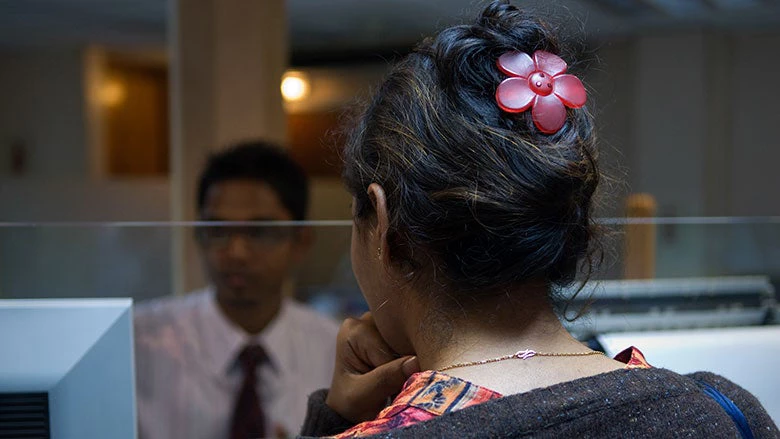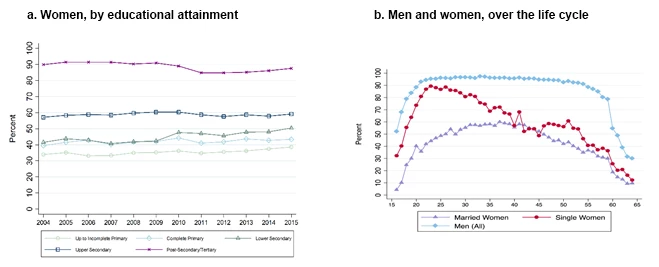
Today, the gender gap in education in middle and high-income countries has mostly disappeared. In some countries, girls outstrip boys in schooling outcomes, yet women earn about 16% less money per hour worked than men (ILO 2018).
Mauritius is no exception. According to data from 2016, out of a student population of 33,269 in tertiary education, 56.6% are female and 43.4% male (Tertiary Education Commission 2017). And yet, the high achievements of girls and young women in school are not carrying over to employment opportunities. The labor force participation rate of women is 57% compared with 88% for men. In the private sector, a Mauritian woman makes only $0.72 cents to a dollar made by men.
The returns to human capital investments in women will continue to fall short if the gender gap in the labor market is not closed. Harnessing the potential of all, including youth and women, is key to unleash the full productivity potential of countries like Mauritius that are facing rapid ageing of their population.
There is good news. Mauritius has gone a long way toward reaching gender equality in the labor market over the course of the last decade. And Mauritius was one of the six top reforming economies in terms of addressing discriminatory laws and regulations that limit women's equality of opportunity (see the World Bank Women, Business and the Law 2019 report). Yet, there is still a long way to go. The labor force participation rate of women has increased steadily up from 46.9% in 2004 to 57% today. Most of the reduction in the gender participation gap is attributable to young cohorts of women, particularly women with secondary educational attainment, who are more likely to work than women who are older or have less schooling (Figure 1, panel a). However, the gap remains sizeable. It widens, still today, as young girls get married and have children, and it never bounces back to the peak reached when girls are between 20 and 25 years old (Figure 1, panel b). And, the progress in participation has not been matched by similar improvements in the gender wage gap. According to a recent report titled Addressing Inequality through More Equitable Labor Markets, between 2004 and 2015, Mauritian women working in the private sector were paid, on average, about 30% less than men per hour worked.
Figure 1. Labor Market Participation, by Gender, Marital Status and Educational Attainment, 2004–15 

What’s the reason for such gap? Both participation and wage gaps are partly explained by differences in observed traits between women and men. In addition to educational attainment, marital status, the presence of infants, children or older family members play a role in the case of participation, and occupation, sector of employment, and enterprise size are important characteristics in the case of wages. However, a considerable portion of the gender gap is not explained by these factors. Something else is going on. Here we speculate about some of the “unobserved” factors which explain gender gaps. Cultural values and social norms assign to Mauritian women a traditional role as providers of children and elderly care and with responsibilities for a broad range of nonmarket or domestic activities. More than 7 in 10 Mauritians report that it is better for a family if a woman has the main responsibility of home and children care (AfroBarometer 2017). Such norms are reflected in different amounts of time spent in household chores and childcare activities by women as opposed to men. Working women devote three times more of their day than working men to these activities: 3.8 hours per day among working women compared with 1.2 hours per day among working men (Central Statistics Office 2005).
The more time women spend in nonmarket activities, the less time they have to pursue employment. And as a result of these norms, women may seek less competitive and less remunerative career paths in exchange for greater employment flexibility. Women are disproportionately employed in traditional sectors and low-skilled occupations. Of course, it is not only self-selection driven by social norms which explains these differences but also discrimination and bias —including in the choice of curricula women pursue in school. And there may be other differences between men and women that we are not (yet) measuring systematically but can explain gender gaps, such as non-cognitive skills.
What to do about it? If policymakers just wait, we can expect to see the participation gap continue to fall, driven by increasing cohorts of better educated women who are more likely to work. And recent legal reforms will help, but more will need to be done to make a dent in closing the gender gaps. There are also many policies that can play an important role to both increase women’s labor force participation and address the wage gap, such as parental leave policies (that are more women friendly and encourage men to take time off after the birth of their child), affordable and available child care (also a good investment for young children as well as working parents), changes in the education system (that open up more fields of study and careers to young women), efforts to shift norms and biases on the employment of women in high-paying positions to name but a few. And lastly, maybe there is something to be learned from the Mauritian public sector about engaging women in the labor market and promoting more equitable treatment, where women are paid slightly more than men.



Join the Conversation